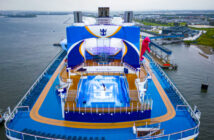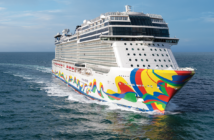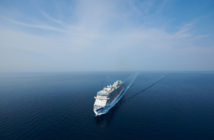Ships of all shapes and sizes are cruising to the traditional Asian ports of Bangkok, Singapore, Hong Kong and Ho Chi Minh City. But the best way to receive an authentic cruise experience in Asia is aboard a smaller ship. To prove the point, I’m travelling on Azamara Journey, which completed significant upgrades in January 2013. Our departure was from the well-known Singapore Cruise Centre (SCC), built in 1991 and progressively modernised to accommodate the growth in the world’s passenger fleets, both in numbers and physical size. Anyone who has travelled through Changi Airport will know how meticulous, forward-looking and organised the Singaporeans are. As such, the centre now copes easily with 1 million cruise passengers a year on top of its considerable local ferry passenger load. Unlike other Asian ports, where you are disgorged onto a flat concrete wharf in between containers and cranes, SCC is like a shopping mall with covered gangways.
Azamara’s ships are perfectly suited to the Asian market. It’s where the line’s policy of longer stays in port so guests can enjoy a better experience really comes into its own. In the words of the line: “We take our time.” Azamara’s brochure explains: “When you’re in the midst of some of the most dazzling cities, renowned UNESCO World Heritage sites, and “I can’t believe we’re here!” places on Earth, the last thing you want to do is rush back to the ship for a 4pm departure (or 5pm if you’re lucky).” “Azamara Club Cruises’ guests have an unquenchable desire to immerse themselves in the history, culture and nightlife of the destinations we visit – which is why we offer them longer stays, more overnights and night touring,” Azamara’s deployment and destinations specialist Claudius Docekal says.
Azamara Journey’s perfect suitability is demonstrated in Ho Chi Minh City, when we are able to sail right up the river and dock almost in front of the central shopping district. From there, the cruise line provided a quick, comfortable and regular shuttle into the centre of town, making it easy for us to stroll at leisure and soak up the city at our own pace. Larger ships would need to use the container port at Phu My, an inconvenient and uncomfortable two-hour road journey from the city. From our drop-off point in Ho Chi Minh central, we are easily able to walk to the famous post office, take a tour of the Independence Palace and the chilling War Remnants Museum, all with plenty of time to shop and pick up some trademark Ho Chi Minh souvenirs like cheap sports shoes and artificially rusted Zippo lighters.
It’s a similar story in Bangkok. When Azamara Journey arrives in the Thai capital, the ship uses the existing, albeit grubby, Klong Toey facility much closer to the city than the alternative (large ship) port of Laem Chabang, which would involve a long transfer. For our visit to Vietnam’s UNESCO World Heritage-listed Halong Bay, all ships are able to use the deepwater port of Cai Lan, where we are transferred to the busy junk terminal. It can get a bit hectic as thousands of tourists are herded aboard a fleet of traditional boats for a cruise among the famous limestone formations. The fully loaded fleet then sails, line astern, out to the fabled location where so many movies and tales are set. Again, thanks to Azamara’s extended port time, we are able to wander around the town and down into the local markets for a true sense of this bustling former North Vietnamese city. I’m pleased to report that we felt completely safe at all times with the locals happily going about their business without paying us much attention at all.
Sailing into Hong Kong, perhaps the most famous of all Asian ports, is a sight that is never forgotten. The dramatic peaks encircle and embrace the harbour with the metropolis perched precariously along the waterfront and up the cliffs. While we did not use the new cruise terminal, which was still under construction when we arrived, I’m reliably informed that the massive, state-of-the-art Kai Tak facility is now in full swing but reserved mainly for the largest of the world’s new wave of mega liners. Azamara Club Cruises continues to use the original Ocean Terminal right next to the Star Ferry terminal. Opened in 1966, the Ocean Terminal is limited to ships of around 100,000 tons and 10-metre draft, while the new Kai Tak terminal will permit two 360-metre vessels of up to 220,000 tons to disembark and clear 5,400 passengers and 1,200 crew at a rate of 3,000 per hour. In a test of the terminal’s capability, Royal Caribbean’s 311-metre, 138,279-ton Mariner of the Seas was the first mega luxury cruise liner to dock at the two-berth terminal in June 2013. While the event was hailed as a success, recent comments about a lack of taxis indicates some fine tuning is required.
At the end of the last century, Hong Kong (Cantonese for “fragrant harbour”) was back in the news with the historic handover of the British colony to the People’s Republic of China. Although many were nervous about the returning Communists, the transition was much less troublesome than many imagined and Hong Kong residents still enjoy special economic and political concessions. Despite recent, high-profile protests, Hong Kong residents still enjoy a more liberal lifestyle than their mainland compatriots. The vast majority of Hong Kong’s 7 million residents are Cantonese-speaking Chinese. Many come from the mainland in search of work in the Special Administrative Region. The city is also home to a large ex-pat population from the US, UK, Canada and Australia, many of whom work in the financial sector.
Getting around this fascinating city is much easier than it must have been in the days when P&O and Qantas published their famous and evocative posters, but Hong Kong still possesses a giddy and frantic persona that will always define this exceptional city.
Roderick Eime



